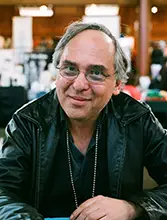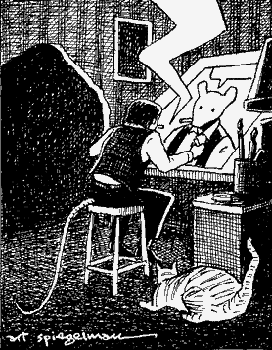Art Spiegelman
(1948 - )

Art Spiegelman is a Jewish American cartoonist, editor and comics advocate. He is most famous for his graphic novel, Maus.
 Back Cover from Maus |
Spiegelman was born Itzhak Avraham ben Zeev on February 15, 1948, in Stockholm. He He immigrated with his parents to the United States in 1951 and grew up in Rego Park, New York.
He began cartooning in 1960 and imitated the style of his favorite comic books, such as Mad. In the early 1960s, he contributed to early fanzines such as Smudge and Skip Williamson’s Squire and, in 1962, while at Russell Sage Junior High School, he produced the Mad-inspired fanzine Blasé.
He was earning money from his drawing by the time he reached high school and sold artwork to the original Long Island Press and other outlets. His talent caught the eyes of United Features Syndicate, who offered him the chance to produce a syndicated comic strip. Dedicated to the idea of art as expression, he turned down this commercial opportunity.
He attended the High School of Art and Design in Manhattan beginning in 1963. He met Woody Gelman, the art director of Topps Chewing Gum Company, who encouraged Spiegelman to apply to Topps after graduating high school.
After he graduated in 1965, Spiegelman's parents urged him to pursue the financial security of a career such as dentistry, but he chose instead to enroll at Harpur College to study art and philosophy. While there, he got a freelance art job at Topps, which provided him with an income for the next two decades.
Spiegelman began selling self-published underground comix on street corners in 1966. He had cartoons published in underground publications such as the East Village Other and traveled to San Francisco for a few months in 1967, where the underground comix scene was just beginning to burgeon.
In late winter 1968, Spiegelman suffered a brief but intense nervous breakdown, which cut short his university studies. He has said that at the time he was taking LSD with great frequency. He spent a month in Binghamton State Mental Hospital, and shortly after he exited it, his mother died by suicide following the death of her only surviving brother.
He moved in San Fransisco from 1971-1975. He moved back to New York City and began doing drawings and comix for the New York Times, Village Voice, and Playboy. He also became an instructor at the School of Visual Arts. In 1979 he co-founded RAW magazine with his wife.
With the intention of creating a book-length work based on his father's recollections of the Holocaust, Spiegelman interviewed his father in 1978 and made a research visit in 1979 to Auschwitz, where his parents had been imprisoned by the Nazis. The book, Maus: A Survivor's Tale was published in 1986. A second volume was published in 1991.
Maus is a nonfiction book presented in the graphic novel style that depicts Spiegelman interviewing his father about his experiences as a Polish Jew and Holocaust survivor. The work employs postmodernist techniques and represents Jews as mice, Germans as cats, Poles as pigs, Americans as dogs, the British as fish, the French as frogs, and the Swedish as deer.
He received National Book Critics Circle Nominations for both books. He got the Special Pulitzer Prize in 1992. Maus has been published in twenty different languages.
In January 2022, the board of trustees of McMinn County Schools in Tennessee removed Maus from its schools’ curriculum. There was significant and widespread backlash to the decision and Maus became the Amazon #1 best-seller. Bookstore owners and others also offered to provide free copies to the students.
Spiegelman currently lives with his wife and two children in Lower Manhattan.
Sources: The International Museum Of Cartoon Art.
“Art Spiegelman,” Wikipedia.
Rachel Treisman, “Why a school board’s ban on ‘Maus’ may put the book in the hands of more readers,” NPR, (January 31, 2022).
Photo: Chris Anthony Diaz, CC BY 2.0 via Wikimedia Commons.
Image courtesy of Comic Connections.


